Tao He
Qwen3Guard Technical Report
Oct 16, 2025Abstract:As large language models (LLMs) become more capable and widely used, ensuring the safety of their outputs is increasingly critical. Existing guardrail models, though useful in static evaluation settings, face two major limitations in real-world applications: (1) they typically output only binary "safe/unsafe" labels, which can be interpreted inconsistently across diverse safety policies, rendering them incapable of accommodating varying safety tolerances across domains; and (2) they require complete model outputs before performing safety checks, making them fundamentally incompatible with streaming LLM inference, thereby preventing timely intervention during generation and increasing exposure to harmful partial outputs. To address these challenges, we present Qwen3Guard, a series of multilingual safety guardrail models with two specialized variants: Generative Qwen3Guard, which casts safety classification as an instruction-following task to enable fine-grained tri-class judgments (safe, controversial, unsafe); and Stream Qwen3Guard, which introduces a token-level classification head for real-time safety monitoring during incremental text generation. Both variants are available in three sizes (0.6B, 4B, and 8B parameters) and support up to 119 languages and dialects, providing comprehensive, scalable, and low-latency safety moderation for global LLM deployments. Evaluated across English, Chinese, and multilingual benchmarks, Qwen3Guard achieves state-of-the-art performance in both prompt and response safety classification. All models are released under the Apache 2.0 license for public use.
Enhancing Feature Fusion of U-like Networks with Dynamic Skip Connections
Sep 18, 2025Abstract:U-like networks have become fundamental frameworks in medical image segmentation through skip connections that bridge high-level semantics and low-level spatial details. Despite their success, conventional skip connections exhibit two key limitations: inter-feature constraints and intra-feature constraints. The inter-feature constraint refers to the static nature of feature fusion in traditional skip connections, where information is transmitted along fixed pathways regardless of feature content. The intra-feature constraint arises from the insufficient modeling of multi-scale feature interactions, thereby hindering the effective aggregation of global contextual information. To overcome these limitations, we propose a novel Dynamic Skip Connection (DSC) block that fundamentally enhances cross-layer connectivity through adaptive mechanisms. The DSC block integrates two complementary components. (1) Test-Time Training (TTT) module. This module addresses the inter-feature constraint by enabling dynamic adaptation of hidden representations during inference, facilitating content-aware feature refinement. (2) Dynamic Multi-Scale Kernel (DMSK) module. To mitigate the intra-feature constraint, this module adaptively selects kernel sizes based on global contextual cues, enhancing the network capacity for multi-scale feature integration. The DSC block is architecture-agnostic and can be seamlessly incorporated into existing U-like network structures. Extensive experiments demonstrate the plug-and-play effectiveness of the proposed DSC block across CNN-based, Transformer-based, hybrid CNN-Transformer, and Mamba-based U-like networks.
Semantic Causality-Aware Vision-Based 3D Occupancy Prediction
Sep 10, 2025Abstract:Vision-based 3D semantic occupancy prediction is a critical task in 3D vision that integrates volumetric 3D reconstruction with semantic understanding. Existing methods, however, often rely on modular pipelines. These modules are typically optimized independently or use pre-configured inputs, leading to cascading errors. In this paper, we address this limitation by designing a novel causal loss that enables holistic, end-to-end supervision of the modular 2D-to-3D transformation pipeline. Grounded in the principle of 2D-to-3D semantic causality, this loss regulates the gradient flow from 3D voxel representations back to the 2D features. Consequently, it renders the entire pipeline differentiable, unifying the learning process and making previously non-trainable components fully learnable. Building on this principle, we propose the Semantic Causality-Aware 2D-to-3D Transformation, which comprises three components guided by our causal loss: Channel-Grouped Lifting for adaptive semantic mapping, Learnable Camera Offsets for enhanced robustness against camera perturbations, and Normalized Convolution for effective feature propagation. Extensive experiments demonstrate that our method achieves state-of-the-art performance on the Occ3D benchmark, demonstrating significant robustness to camera perturbations and improved 2D-to-3D semantic consistency.
S$^4$C: Speculative Sampling with Syntactic and Semantic Coherence for Efficient Inference of Large Language Models
Jun 17, 2025Abstract:Large language models (LLMs) exhibit remarkable reasoning capabilities across diverse downstream tasks. However, their autoregressive nature leads to substantial inference latency, posing challenges for real-time applications. Speculative sampling mitigates this issue by introducing a drafting phase followed by a parallel validation phase, enabling faster token generation and verification. Existing approaches, however, overlook the inherent coherence in text generation, limiting their efficiency. To address this gap, we propose a Speculative Sampling with Syntactic and Semantic Coherence (S$^4$C) framework, which extends speculative sampling by leveraging multi-head drafting for rapid token generation and a continuous verification tree for efficient candidate validation and feature reuse. Experimental results demonstrate that S$^4$C surpasses baseline methods across mainstream tasks, offering enhanced efficiency, parallelism, and the ability to generate more valid tokens with fewer computational resources. On Spec-bench benchmarks, S$^4$C achieves an acceleration ratio of 2.26x-2.60x, outperforming state-of-the-art methods.
DiscoVLA: Discrepancy Reduction in Vision, Language, and Alignment for Parameter-Efficient Video-Text Retrieval
Jun 10, 2025Abstract:The parameter-efficient adaptation of the image-text pretraining model CLIP for video-text retrieval is a prominent area of research. While CLIP is focused on image-level vision-language matching, video-text retrieval demands comprehensive understanding at the video level. Three key discrepancies emerge in the transfer from image-level to video-level: vision, language, and alignment. However, existing methods mainly focus on vision while neglecting language and alignment. In this paper, we propose Discrepancy Reduction in Vision, Language, and Alignment (DiscoVLA), which simultaneously mitigates all three discrepancies. Specifically, we introduce Image-Video Features Fusion to integrate image-level and video-level features, effectively tackling both vision and language discrepancies. Additionally, we generate pseudo image captions to learn fine-grained image-level alignment. To mitigate alignment discrepancies, we propose Image-to-Video Alignment Distillation, which leverages image-level alignment knowledge to enhance video-level alignment. Extensive experiments demonstrate the superiority of our DiscoVLA. In particular, on MSRVTT with CLIP (ViT-B/16), DiscoVLA outperforms previous methods by 1.5% in R@1, reaching a final score of 50.5% R@1. The code is available at https://github.com/LunarShen/DsicoVLA.
FuseUNet: A Multi-Scale Feature Fusion Method for U-like Networks
Jun 06, 2025Abstract:Medical image segmentation is a critical task in computer vision, with UNet serving as a milestone architecture. The typical component of UNet family is the skip connection, however, their skip connections face two significant limitations: (1) they lack effective interaction between features at different scales, and (2) they rely on simple concatenation or addition operations, which constrain efficient information integration. While recent improvements to UNet have focused on enhancing encoder and decoder capabilities, these limitations remain overlooked. To overcome these challenges, we propose a novel multi-scale feature fusion method that reimagines the UNet decoding process as solving an initial value problem (IVP), treating skip connections as discrete nodes. By leveraging principles from the linear multistep method, we propose an adaptive ordinary differential equation method to enable effective multi-scale feature fusion. Our approach is independent of the encoder and decoder architectures, making it adaptable to various U-Net-like networks. Experiments on ACDC, KiTS2023, MSD brain tumor, and ISIC2017/2018 skin lesion segmentation datasets demonstrate improved feature utilization, reduced network parameters, and maintained high performance. The code is available at https://github.com/nayutayuki/FuseUNet.
Knowledge-Aligned Counterfactual-Enhancement Diffusion Perception for Unsupervised Cross-Domain Visual Emotion Recognition
May 26, 2025Abstract:Visual Emotion Recognition (VER) is a critical yet challenging task aimed at inferring emotional states of individuals based on visual cues. However, existing works focus on single domains, e.g., realistic images or stickers, limiting VER models' cross-domain generalizability. To fill this gap, we introduce an Unsupervised Cross-Domain Visual Emotion Recognition (UCDVER) task, which aims to generalize visual emotion recognition from the source domain (e.g., realistic images) to the low-resource target domain (e.g., stickers) in an unsupervised manner. Compared to the conventional unsupervised domain adaptation problems, UCDVER presents two key challenges: a significant emotional expression variability and an affective distribution shift. To mitigate these issues, we propose the Knowledge-aligned Counterfactual-enhancement Diffusion Perception (KCDP) framework. Specifically, KCDP leverages a VLM to align emotional representations in a shared knowledge space and guides diffusion models for improved visual affective perception. Furthermore, a Counterfactual-Enhanced Language-image Emotional Alignment (CLIEA) method generates high-quality pseudo-labels for the target domain. Extensive experiments demonstrate that our model surpasses SOTA models in both perceptibility and generalization, e.g., gaining 12% improvements over the SOTA VER model TGCA-PVT. The project page is at https://yinwen2019.github.io/ucdver.
Simulating Before Planning: Constructing Intrinsic User World Model for User-Tailored Dialogue Policy Planning
Apr 18, 2025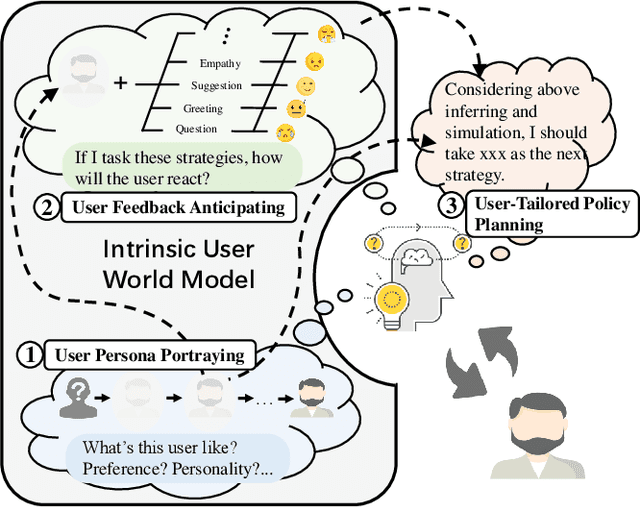
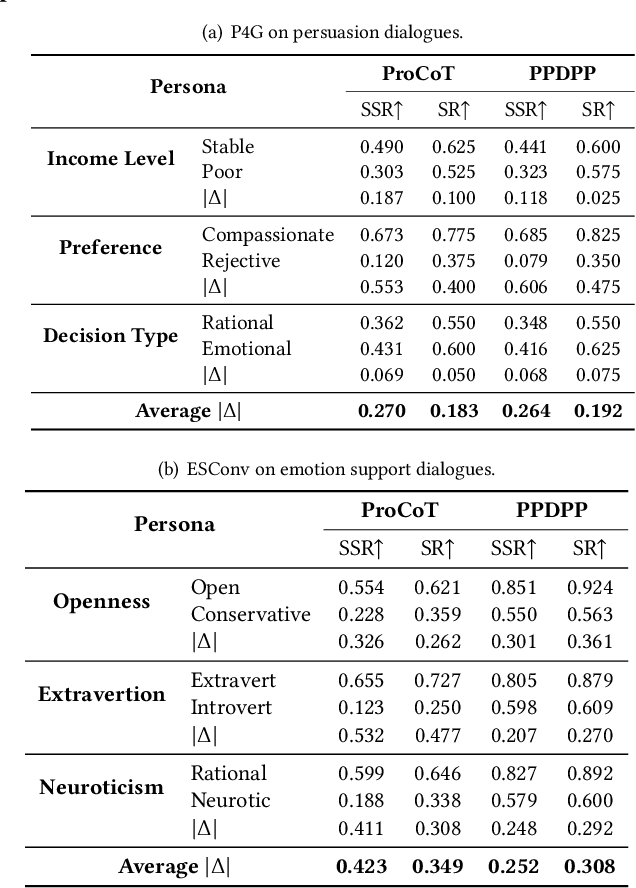
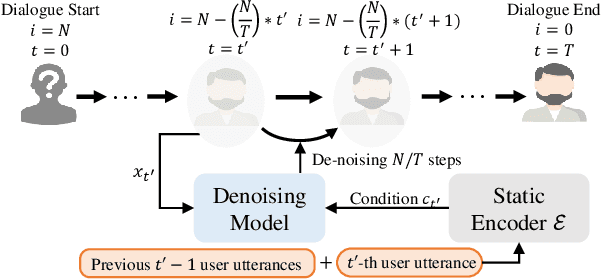
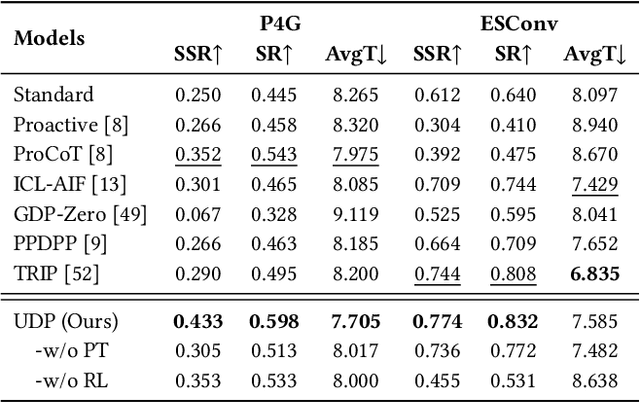
Abstract:Recent advancements in dialogue policy planning have emphasized optimizing system agent policies to achieve predefined goals, focusing on strategy design, trajectory acquisition, and efficient training paradigms. However, these approaches often overlook the critical role of user characteristics, which are essential in real-world scenarios like conversational search and recommendation, where interactions must adapt to individual user traits such as personality, preferences, and goals. To address this gap, we first conduct a comprehensive study utilizing task-specific user personas to systematically assess dialogue policy planning under diverse user behaviors. By leveraging realistic user profiles for different tasks, our study reveals significant limitations in existing approaches, highlighting the need for user-tailored dialogue policy planning. Building on this foundation, we present the User-Tailored Dialogue Policy Planning (UDP) framework, which incorporates an Intrinsic User World Model to model user traits and feedback. UDP operates in three stages: (1) User Persona Portraying, using a diffusion model to dynamically infer user profiles; (2) User Feedback Anticipating, leveraging a Brownian Bridge-inspired anticipator to predict user reactions; and (3) User-Tailored Policy Planning, integrating these insights to optimize response strategies. To ensure robust performance, we further propose an active learning approach that prioritizes challenging user personas during training. Comprehensive experiments on benchmarks, including collaborative and non-collaborative settings, demonstrate the effectiveness of UDP in learning user-specific dialogue strategies. Results validate the protocol's utility and highlight UDP's robustness, adaptability, and potential to advance user-centric dialogue systems.
Rethinking Temporal Fusion with a Unified Gradient Descent View for 3D Semantic Occupancy Prediction
Apr 18, 2025Abstract:We present GDFusion, a temporal fusion method for vision-based 3D semantic occupancy prediction (VisionOcc). GDFusion opens up the underexplored aspects of temporal fusion within the VisionOcc framework, focusing on both temporal cues and fusion strategies. It systematically examines the entire VisionOcc pipeline, identifying three fundamental yet previously overlooked temporal cues: scene-level consistency, motion calibration, and geometric complementation. These cues capture diverse facets of temporal evolution and make distinct contributions across various modules in the VisionOcc framework. To effectively fuse temporal signals across heterogeneous representations, we propose a novel fusion strategy by reinterpreting the formulation of vanilla RNNs. This reinterpretation leverages gradient descent on features to unify the integration of diverse temporal information, seamlessly embedding the proposed temporal cues into the network. Extensive experiments on nuScenes demonstrate that GDFusion significantly outperforms established baselines. Notably, on Occ3D benchmark, it achieves 1.4\%-4.8\% mIoU improvements and reduces memory consumption by 27\%-72\%.
LLaVA-MLB: Mitigating and Leveraging Attention Bias for Training-Free Video LLMs
Mar 14, 2025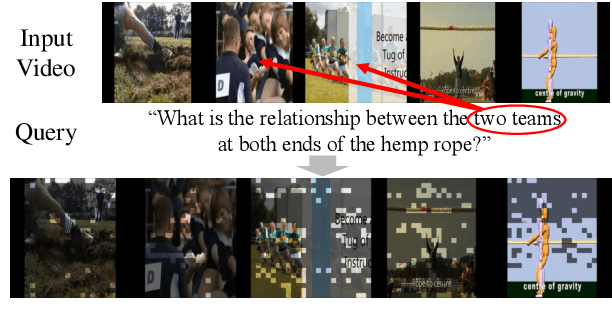

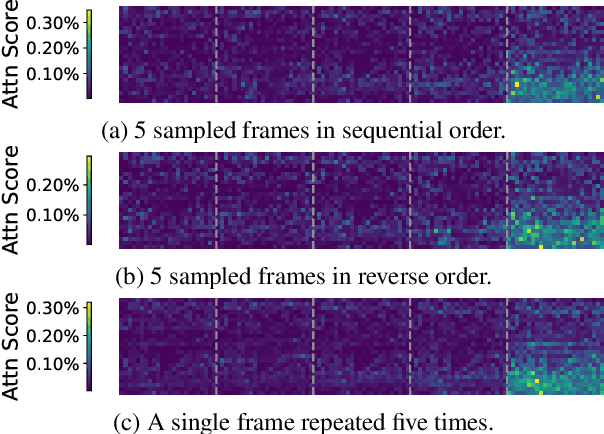
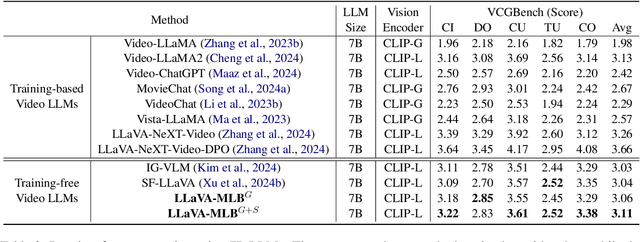
Abstract:Training-free video large language models (LLMs) leverage pretrained Image LLMs to process video content without the need for further training. A key challenge in such approaches is the difficulty of retaining essential visual and temporal information, constrained by the token limits in Image LLMs. To address this, we propose a two-stage method for selecting query-relevant tokens based on the LLM attention scores: compressing the video sequence and then expanding the sequence. However, during the compression stage, Image LLMs often exhibit a positional attention bias in video sequences, where attention is overly concentrated on later frames, causing early-frame information to be underutilized. To alleviate this attention bias during sequence compression, we propose Gridded Attention Pooling for preserving spatiotemporal structure. Additionally, we introduce Visual Summarization Tail to effectively utilize this bias, facilitating overall video understanding during sequence expansion. In this way, our method effectively Mitigates and Leverages attention Bias (LLaVA-MLB), enabling the frozen Image LLM for detailed video understanding. Experiments on several benchmarks demonstrate that our approach outperforms state-of-the-art methods, achieving superior performance in both efficiency and accuracy. Our code will be released.
 Add to Chrome
Add to Chrome Add to Firefox
Add to Firefox Add to Edge
Add to Edge